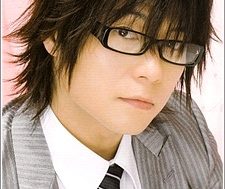
(A picture from the first Kuroshitsuji seiyuu event.)
If you’re an anime fan, it’s likely that there are at least a few voices that you’re used to hearing. There’s a certain satisfaction, as well as a moment of awkward geekdom, when a character appears for the first time and you can flap your hand at the screen and claim oh, I know this person! They voice so-and-so in such-and-such anime. Okay, so perhaps not everyone actually does this aloud but the moment of recognition has probably happened to you at least once. And for a lot of people, perhaps that’s where it ends. If you get curious enough to look up a cast list, find an actor name and start Googling you could be about to get drawn in to the surprisingly vast world of seiyuu.
And why shouldn’t you? There’s a lot of cool stuff going on, if you take the time to look it up. If you’re curious, keep reading.
So what exactly is a seiyuu? Most simply, a Japanese voice actor. Just like any other voice actor, a seiyuu’s job is to portray a variety of characters across animation, games and films through their voice alone. In most countries, this would pretty much sum it up. In Japan, being a seiyuu means a lot more. Not only do they act in anime and games but they record radio dramas and drama CDs, they take part in live events and performances, they launch music careers and singing tends to be an important part of their jobs anyway, with character CDs being released for a variety of anime and games. Some seiyuu even branch out into more traditional acting on the stage, on television or in movies.
Nana Mizuki is a brilliant example of how far a seiyuu’s career can extend beyond merely acting. A singer-songwriter as well as an actress, Nana has released eight albums since her music debut in 2000 and has topped the weekly Oricon charts with both singles and albums. In that time, she’s also released an autobiography, played live at the Tokyo Dome concert hall and was last year’s Animation Artist of the Year in the Billboard Japan Music Awards among all sorts of other things. With plenty of anime roles also under her belt since 1998, Nana could be described as a seiyuu idol and the term ‘voice actress’ does not seem enough to describe her career.
In Japan, being a voice actor is far more than just being a voice. There are tons of schools for seiyuu in training as well as numerous groups, agencies and companies that manage own sets of seiyuu. More famous or experiences seiyuu have also been known to open their own agencies and school. AXLONE is a relatively new company founded in early 2012 by seiyuu Toshiyuki Morikawa, known for roles in anime including D. Gray Man (Tyki Mikk) and InuYasha (Naraku) as well as games including Dissidia: Final Fantasy (Sephiroth) and BioShock (Atlas). Morikawa also dubs a vast array of foreign films into Japanese. Soon after its introduction, AXLONE has snagged other successful seiyuu including Jun Fukuyama (Grell Sutcliffe, Kuroshituji) , and Noriaki Sugiyama (England, Axis Powers Hetalia) and it continues to grow. Competition between seiyuu companies seems almost as difficult as competiton between seiyuu.
When it comes to performances, festivals happen each year such as Animelo Summer Live attended by numerous seiyuu and anime-related bands and thousands of fans. This year’s festival, scheduled for August 25th and 26th will feature seiyuu Daisuke Ono (Shizuo Heiwajima, Durarara!!) and Eri Kitamura (Saya Otonashi, Blood+) as well as singer May’n (singing voice of Sheryl Nome, Macross Frontier) and unit GRANRODEO, fronted by seiyuu Kishou Taniyama (Natsuki Shinomiya, Uta no Prince-Sama). There are also anime, game or radio specific live events constantly taking place, with musical performances, live dubbing and other types of general silliness being carried out by the casts. Since 2007, there has also been a yearly Seiyuu Awards to recognise successful individuals or groups for their performances that year. This year’s winners included Hiroaki Hirata (Kotetsu T. Kaburagi, Tiger and Bunny) and Aoi Yuki (Kaname Madoka, Puella Magi Madoka Magica) as Best Lead Actor and Actress while fan favourite Hiroshi Kamiya, mentioned in our previous article on the new anime Shirokuma Café, won the Most Votes Award.
Keeping track of all of this is the magazine Voice Animage, first published from 1994 to 2002 and then resurrected in 2009. A full colour and glossy magazine, it covers all aspects of the seiyuu industry and highlights both actors, actresses, upcoming releases and seiyuu related bands. With so much happening all the time, it’s no wonder that there are several magazines dedicated to the industry.
With all of this going on, it’s not surprising that the seiyuu fanbase is huge, dedicated and at times downright frightening. An image is an important thing to maintain for any celebrity and for female seiyuu in particular, being successful not only requires talent but also respectable behaviour. Those unlucky enough to find themselves involved in scandalous news or even to announce themselves as taken are often in for an unhappy response. An incident in 2011 involving Aya Hirano, famed for her role as the infamous Haruhi Suzumiya, and some suspicious photographs led to her leaving her agency and only recently beginning to reappear. If she was less popular, it’s not a certainty that she would have reappeared at all.
Whether you’re already a dedicated fan of particular seiyuu or whether you’re just curious as to what all this hype has been about, you’ve just heard briefly about some aspects of a thriving and busy industry. We’ll be covering the different aspects of it all with focus on particular seiyuu that you might recognise soon, starting with a look at anime and game roles.















